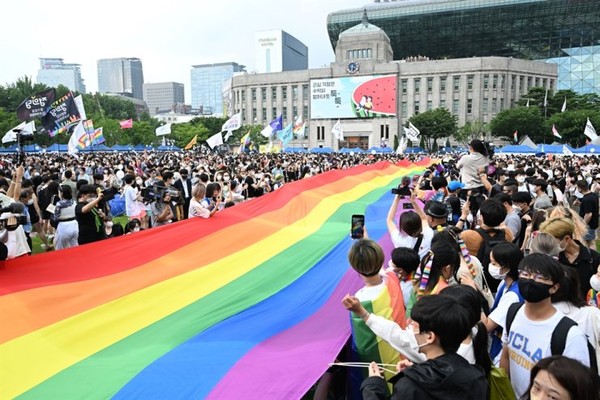
It’s that time of the year again when we hear about all the different perspectives on Pride Month celebrations and the LGBTQ+ community everywhere, all at once. There will be people marching in the streets, all around the world, to advocate for queer inclusion and against discrimination, and there will be those opposing them on moral or religious grounds. Korea is no exception: the tug-of-war has begun, with the Seoul Metropolitan Government rejecting the annual Seoul Queer Cultural Festival’s (SQCF) request to use Seoul Plaza on July 1 in favor of a concert by the Christian CTS Cultural Foundation. Part of the justification, according to a transcript of the civic committee meeting to make the decision, was that “other citizens also have the right to not want to see that.” One might wonder about what goes on at SQCF every year that could be so controversial for there to be consistent opposition every time.
I was lucky enough to attend SQCF last year, held at Seoul Plaza in front of City Hall. The entire festival was a two-week long celebration in July, and I was there on July 16, which was the highlight of the festival: the Seoul Queer Parade (SQP). It was the first time I ever attended such an event here in Korea, a country not exactly known for queer inclusivity, so I didn’t know what to expect. But it ended up being a great and memorable experience, despite the inclement weather. There were dozens of booths along the edges of the plaza, each hosted by a different civic group or company. The booths allowed participants to play games, handed out freebies, and presented their own advocacy related to the queer community. (One such booth, for instance, gave out free fans with information about where to get tested for HIV for free.)
There were also great song and dance performances by various individuals and groups: performances that weren’t necessarily “queer-themed” but were nonetheless an entertaining showcase of talent and expression. Attendees sat on the grass as they watched: some brought their own picnic mats, while others huddled under umbrellas. There was a noticeable number of queer couples being openly affectionate: women lying close beside each other on the grass, men holding hands and kissing in the rain. It was palpable that this was, perhaps, the only day in the year and the only place in Korea they could express their love in public and in broad daylight. Some foreign diplomats also gave speeches supporting the cause, including ambassadors from Denmark, New Zealand, the UK, Canada, and the US.
The parade itself was a procession that lasted almost two hours. Thousands of us — Korean and foreigner alike — allowed ourselves to be drenched in the rain, our umbrellas rendered useless by the wind, as we marched the streets of Seoul, brandishing our rainbow paraphernalia as counter-protesters lined the sidewalks with placards about how homosexuality is a sin, queer people are abominations, and Pride celebrations are Western indoctrination. In some bizarre way, I couldn’t help but admire the counter-protesters for their commitment to their cause: standing and waiting in the rain for hours just to deny other people’s right to exist.
Despite the thousands of attendees, the number of stakeholders involved, the many activities in the program, the uncooperative weather, and the persistent counter-protesters, SQCF 2022 was remarkably well-organized. The entrances and exits were managed to ensure the crowds were safe, and the parade was marshaled accordingly. There was an infirmary with medical professionals and volunteers, and a help desk for reporting any incident. Gender-neutral restrooms were set up in the plaza, and all facilities were wheelchair-accessible.
Other Pride events around the world have their own way of commemorating the queer community. For instance, drag performances are sometimes a huge part of some Pride Month celebrations in countries where drag performers are more comfortable being seen in public. In places where the LGBTQ+ community are still shunned and suppressed, Pride becomes more of a protest, like the women’s suffrage movements of the 19th and 20th centuries or the civil rights marches of the 1960s. Perhaps the only thing you can reliably expect from a Pride event is that there will be people complaining about it. But at SQCF, it was a peaceful event with no “harmful obscene material” that might be inappropriate for public display.
One last question one might ponder is why SQCF has been scheduled in July in recent years, rather than June, which is internationally recognized as Pride Month. The reason, of course, is that anti-LGBTQ+ groups often book public venues for the entire month of June in advance to preempt Pride Month events, organizing their own festivals. Government officials also attempt to delay granting permits to SQCF for as long as possible to make it more inconvenient for them to organize a successful event. Despite these setbacks, SQCF has been held successfully every year since it began, except for the two years during the pandemic.
Why is it so important, then, to have Pride celebrations like SQCF? Perhaps it doesn’t have to be “important”. Does there have to be a particularly compelling reason for a festival to be held? All I know is that everyone at SQCF seemed to be happy being there, whether they were Korean or not, straight or queer, young or old. We stayed despite the heavy downpour because we were enjoying the event. And when the storm subsided after the parade ended, I thought about the counter-protesters we saw along the way, just as wet as we were but without smiles on their faces.
Did the God they believe in make it rain for us or for them? I wouldn’t presume to know the answer, but I do know what you see when you look at the sky after it rains.

